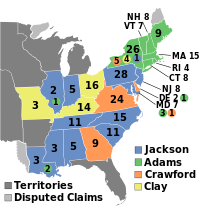1824 United States elections
| ←18221823182418251826→ Presidential election year | |
| Incumbent president | James Monroe (Democratic-Republican) |
|---|---|
| Next Congress | 19th |
| Presidential election | |
| Partisan control | Democratic-Republican hold |
| Electoral vote | |
| John Quincy Adams(DR) | 84[1] |
| Andrew Jackson(DR) | 99 |
| William H. Crawford(DR) | 41 |
| Henry Clay(DR) | 37 |
 | |
| 1824 presidential election results.Bluedenotes states won by Jackson,orangedenotes those won by Crawford,greendenotes those won by Adams,light yellowdenotes those won by Clay. Numbers indicate the number of electoral votes allotted to each state. | |
| Senate elections | |
| Overall control | Jacksonian gain |
| Seats contested | 16 of 48 seats[2] |
| Net seat change | Jacksonian +25[3] |
| House elections | |
| Overall control | Anti-Jacksonian gain |
| Seats contested | All 213 voting members |
| Net seat change | Anti-Jacksonian +22[3] |
The1824 United States electionselected the members of the19th United States Congress.It marked the end of theEra of Good Feelingsand theFirst Party System.The divided outcome in the 1824 presidential contest reflected the renewed partisanship and emerging regional interests that defined a fundamentally changed political landscape. The bitterness that followed the election ensured political divisions would be long-lasting and facilitated the gradual emergence of what would eventually become theSecond Party System.Members of theDemocratic-Republican Partycontinued to maintain a dominant role in federal politics, but the party became factionalized between supporters ofAndrew Jacksonand supporters ofJohn Quincy Adams.TheFederalist Partyceased to function as a national party, having fallen into irrelevance following a relatively strong performance in1812.
In the first close presidential election since the1812 election,four major candidates ran, all of whom were members of theDemocratic-Republican Party.The Democratic-Republicans had largely been successful in fielding only one presidential candidate in previous elections (except in1812), but the breakdown of thecongressional nominating caucusand a lack of meaningful opposition from the Federalists allowed for a multi-candidate field. SenatorAndrew Jacksonfrom Tennessee, Secretary of StateJohn Quincy Adams,Secretary of the TreasuryWilliam Crawford,and Speaker of the HouseHenry Clayall receivedelectoral votes.With no candidate receiving a majority of the electoral vote, the Housechoseamong the three candidates (Jackson, Adams, and Crawford) with the most electoral votes. Although Jackson won a plurality of electoral and popular votes, the House elected Adams as president.[4]Despite the chaos in the presidential election,John C. Calhounwon the vice presidency with a majority of electoral votes.
The 1824 presidential election was the only time that the House elected the president under the terms of theTwelfth Amendment,and the only time that thewinnerof the mostelectoral votesdid not win the presidency. This was the first occasion where the candidate who won the popular vote did not win the presidency. Adams's victory ended theVirginia dynastyof presidents, but continued the trend of the incumbentsecretary of statewinning election as president.
In theHouse,Democratic-Republicans continued to command a dominant majority. Supporters of Adams narrowly outnumbered supporters of Jackson.[5]John W. Taylor,who would later join Adams'sNational Republicans,was electedSpeaker of the House.
In theSenate,Democratic-Republicans continued to command a dominant majority. Supporters of Jackson narrowly outnumbered supporters of Adams.[6]
See also
[edit]- 1824 United States presidential election
- 1824–1825 United States House of Representatives elections
- 1824–1825 United States Senate elections
References
[edit]- ^As no presidential candidate won a majority of the electoral vote, the House of Representatives held a contingent election. Adams won that contingent election.
- ^Not counting special elections.
- ^abCongressional seat gain figures only reflect the results of the regularly scheduled elections, and do not take special elections into account.
- ^"1824 Presidential Election".The American Presidency Project.Retrieved25 June2014.
- ^"Party Divisions of the House of Representatives".United States House of Representatives.Retrieved25 June2014.
- ^"Party Division in the Senate, 1789-Present".United States Senate.Retrieved25 June2014.
